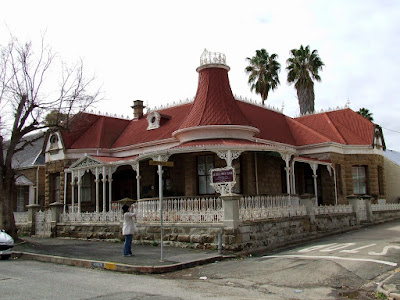Ostrich Feather Palaces
Oudsthoorn became known world-wide due to the ostrich feather
industry. From about 1860 it was high
fashion for ladies to use ostrich feathers as decoration on their outfits. Between 1900 and 1914 the price was
unbelievable high and the farmers and merchants in Oudtshoorn reaped the
rewards.
Numerous immigrants, particularly the Jews, were drawn to the “boom”
town. Soon a rivalry started between the farmers and merchants to see who could
build the most beautiful homes or “ostrich feather palaces”. Beautiful homes were built with stained glass
windows, cast-iron work (“broekielace”) and turrets.
Here are a few of the ostrich palaces we found while walking in
Oudtshoorn in Aug 2013:
Le Roux House (46 High Street)
The
house was built for JHJ le Roux. It was designed by Charles Bullock and was
built during 1909 and 1910. It is now
part ot the CP Nel Museum but the ouside of the building look terrible. The museum was closed and we could not go
inside to see if they take better care of is the inside. (We visited in Aug 2013. We have not returned yet and I do not know
the current condition of the house)
Read here for more information.
Gottland House (72 Baron van Rheede Street)
This house was designed by
Charles Bullock in 1902. It is currently a retirement home.
Mimosa
Lodge (85 Baron van Reede Street)
This house was designed by
Charles Bullock in 1907 for a jewish merchant, Robert Sladowski. It was built using local sandstone.
Read this article about the centenary
of the house in 2007.
Montague House (12 Baron van Rheede Street)
This house was possibly designed
by Charles Bullock. It was built for the
Lipschitz-family. In 2007 the house was restored by Mr Bernard Esterer and is
now the Montague House restaurant.









Comments
Post a Comment